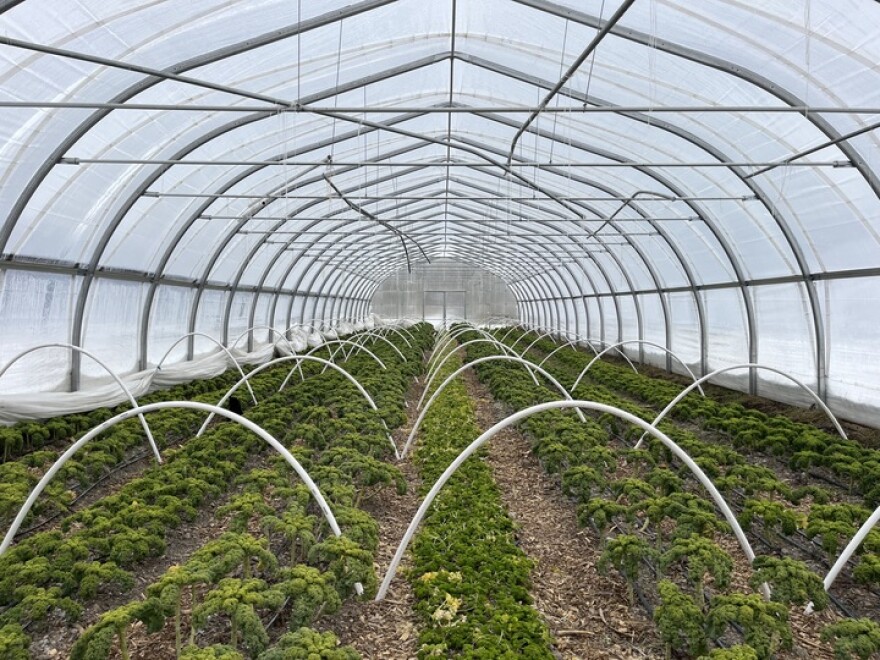It’s early March, and there is snow on the ground, but inside a hoop house at Bread & Butter Farm in Shelburne it’s at least 25 degrees warmer.
Rayna Joyce is a vegetable production manager at the farm.
A hoop house is a lightweight greenhouse made up of heavy plastic sheeting and a series of arch-like tubes. Bread & Butter has three, and they use them to grow winter greens during Vermont’s harsh winter.
Here’s how it works.
While warm is good in the winter, too warm is a problem. On a full sun day, Joyce says, the hoop house can reach 70 or 80 degrees.
“We actually want the winter greens to stay generally at a lower temperature, because we're working on hardening them off and making them capable of handling cold and they actually are more adapted to want colder temperatures. So they don't actually do well in super hot conditions,” Joyce says. “So basically, it's this game of trying to give the plants as much cold exposure as they can tolerate, and then to slowly kind of bring down the temperature that they're able to withstand.”
According to Joyce, some hardy winter greens such as kale and spinach are vulnerable to diseases and pests if things get too hot.
That means every day is like trying to find Goldilocks’ oatmeal that is just right — every morning, it’s a different calculation.
On a warm and sunny day, Joyce will remove any insulation from the beds, roll up the plastic panels on the side of the hoop house, and open the two entrance doors to supply airflow.
But during a deep winter freeze, these steps are reversed.
When temperatures ducked below -20 in early February, Joyce had three hoop houses full of curly kale, spinach and parsley to keep warm.
“I would say anything of that cold nature is a little concerning for us. And always just a question of like, how well will things do and there's so many different variables that can affect that,” Joyce says.
To prevent the vegetables from freezing over during the cold snap, Joyce covered the beds with two layers of a blanket-like fabric called Remay.

Each layer of Remay adds eight degrees of warmth for the plants. Joyce says that Remay is essentially a warm blanket for vegetable beds.
“So part of you making Remay work effectively is that you don't want it to ideally be in direct contact with the plant itself,” Joyce says. “So you don't want that like cold fabric resting on it. Because that can again, form like ice damage, like on the actual plant. It's like actually the airspace between like your body and the like, blanket or whatever, that's creating the most heat.”
And even with all of the tools in her toolkit, Joyce says when it gets super cold there’s only so much she can do. Vegetables at the center of the hoop house retain the most heat, while the crops on the edges are most susceptible to cold damage.
“I just sort of assumed that I'm going to maybe lose like, 50% of that when it gets really cold,” Joyce says. “And I just try to harvest as much prior to that happening. But you know, it's just sort of, yeah, an expected loss.”
And one of the biggest tools to growing vegetables in the winter happens before the cold season even begins.
At Bread & Butter, the winter greens are planted in September, before heading into what Joyce calls a “dormant period.”
“All of the foliage that's on the plant by say, mid-November is like what there's going to be on the plant until sometime in like late February, early March,” Joyce says.
Bread & Butter puts out roughly 120 Community Supported Agriculture (CSA) shares a week. Most of the produce comes from partner farms, with the exception of the hardy winter greens. Joyce says that customers will notice that the winter greens have a delicious, sweet taste.
Vern Grubinger, a vegetable and berry specialist at University of Vermont Extension, says there’s actually a physiological explanation for why Vermont’s most bitter temperatures produce the sweetest greens.
“There are actually a lot of vegetables that get sweeter and have their flavor improved after being exposed to some cold,” Grubinger says. And that's again back to the idea that the way they respond is by forming sugars in the cells to sort of serve as an antifreeze.”
He explains plants have evolved to tolerate cold by having a lot of dissolved materials in their cells like sugars. Sugar water freezes at a lower temperature than water, which prevents the vegetables from freezing.
Back at the farm, spinach is being harvested for this week’s round of CSA boxes.
In a few short weeks, the hoop houses will be prepped for summer crops, such as tomatoes, eggplants and peppers. But thinking towards next year's winter season, Joyce says she is interested in experimenting with some new greens.
“You can grow some varieties of salad mixes or arugula through the winter, they're a little less cold-hardy,” Joyce says. “But it also feels like we've kind of found our niche and it's going well for us.”
Have questions, comments or tips? Send us a message.





